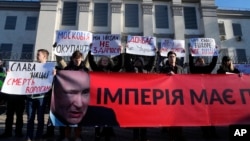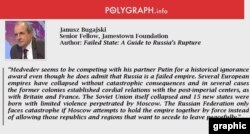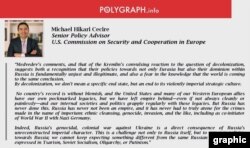On February 26, President Vladimir Putin told the weekly TV show “Moscow. Kremlin. Putin.” that Western countries "have one goal: to disband … the Russian Federation."
On February 27, former president Dmitry Medvedev elaborated on Putin’s theme in the Izvestia newspaper op-ed. Describing Russia as an empire, Medvedev claimed:
“History also demonstrates something else: any collapsed empire buries half the world, or even more, under its rubble. It seems that those who first destroyed the USSR and now are trying to destroy the Russian Federation do not want to comprehend this."
That is false.
The collapse of most empires did not destroy half the world, but rather was followed by political turbulence or wars limited to that empire's territory.
An empire is a political construct that dates back to early antiquity and features authoritarian control extending from one center to vast territories and/or a large number of peoples.
According to various estimates, there have been some 50-70 empires in recorded history. We will consider the collapse of only the five largest of them and assess what damage it caused to the world.
British Empire
The British Empire was the largest in history. In 1913, its population was 412 million (23 percent of the world's population). As of 1920, it occupied 35.5 million square kilometers (24 percent of the planet's total land area), which explains why the phrase “The empire on which the sun never sets” was used to describe it.
Britain generally pursued a policy of peaceful withdrawal from its colonies, although violence took place in British Malaya, Kenya and Palestine.
As many as 2 million people were killed and up to 15 million uprooted in the partition of India, which was the result of The Indian Independence Act 1947, an act of the British Parliament.
The empire gradually became the British Commonwealth, “a voluntary association of independent and equal sovereign states.”
Mongol Empire
The Mongol Empire existed from 1206 to 1368 and was the largest Eurasian and contiguous land empire in history.
The collapse of the Mongol Empire took place in several stages for 74 years and was accompanied by uprisings by peoples who had been conquered by the Mongols. The world outside this empire did not experience any catastrophic consequences due to its collapse.
Russian Empire
The Russian Empire incorporated dozens of peoples in Eurasia from 1721 to 1917. At its height in 1895, it encompassed 22.8 million square kilometers.
The Russian Empire collapsed after Emperor Nicholas II's abdication on March 2, 1917.
The Bolsheviks seized power in Russia in October 1917, which led to a civil war that lasted from 1918 to 1922 and ended with the formation of the Soviet Union.
As many as 10 million people died in the Russian Civil War, while more than 1 million others, mainly opponents of the Bolsheviks, were forced to flee Russia.
The Union of Soviet Socialist Republics (USSR)
The Russian Empire’s successor, the Soviet Union, existed from 1922 to 1991 and covered 22.4 square kilometers. In 1989, 286.7 million people lived in the USSR, making it the world’s third most populous country.
The final blow to the Soviet empire was an unsuccessful coup by hardliners in the ruling Soviet Communist Party in August 1991. That weakened the power of Soviet President Mikhail Gorbachev, and according to History.com, propelled “democratic forces, led by Boris Yeltsin, to the forefront of Russian politics.”
Here is how the disappearance of the Soviet Empire from the world map is described on the website of the U.S. State Department:
“…Mikhail Gorbachev resigned his post as president of the Soviet Union, leaving Boris Yeltsin as president of the newly independent Russian state. People all over the world watched in amazement at this relatively peaceful transition from former Communist monolith into multiple separate nations.”
Qing Dynasty
The Qing Dynasty, the last imperial dynasty in China, lasted from 1644 to 1912. It occupied 14.7 million square kilometers, while its population, at its peak in 1850, reached 430 million, or 34 percent of the world's population.
The Qing Dynasty's fall did not have catastrophic consequences for the world. It led to the establishment of the Republic of China, with the leader of the Kuomintang National Party, Sun Yat-sen, proclaimed as its first president.







